
360 Recruitment: A Complete Guide for 2025

Tired of fragmented recruitment workflows? The 360 recruitment process offers a streamlined, end-to-end solution.
By owning every stage, from business development to post-placement follow-up, recruiters gain unprecedented control and deliver exceptional results.
Let’s explore how a 360 recruitment approach can boost your agency’s performance in this guide, providing a complete strategy that covers every step of the hiring process for maximum impact
What is a 360 Recruitment Process?
360 recruitment is an end-to-end recruitment strategy where you, as a recruiter, handle literally every stage of the hiring process – from the moment a client says “We need to hire someone” all the way through to the candidate’s successful onboarding.
It’s called “360” because you’re coming full circle through the entire recruitment lifecycle to leave no stone unturned.
Unlike traditional recruitment methods that often fragment responsibilities across different specialists or teams, 360 recruitment puts you in the driver’s seat throughout the journey.
You’re not just the matchmaker – you’re the relationship counselor, the wedding planner, and the photographer all rolled into one!
In a traditional setup, you might have individuals finding candidates, account managers handling client relationships, and interview coordinators managing the selection process.
But in 360 recruitment? You are a one-man army.
At its heart, 360 recruitment is about adopting a skill-centric and data-driven approach rather than relying on gut feelings or rushing to fill positions. It’s strategic and focused on quality over speed (though, ironically, it often speeds things up anyway).
The approach is particularly valuable when handling bulk hiring for similar candidate profiles. But don’t be fooled – this isn’t about becoming robotic. It’s quite the opposite!
By managing the entire process, you can:
- Build deeper, more meaningful relationships with your clients.
- Gain a thorough understanding of the roles you’re recruiting for.
- Connect with candidates on a more personal level.
- Maintain quality control throughout the entire journey.
- Create a seamless experience for both clients and candidates.
The Essential Components of a 360 Recruitment Process
While we’ll dive deeper into the stages in another section, let’s quickly touch on what makes up this comprehensive approach:
- Job requirement analysis – Work closely with hiring managers to truly understand what they need.
- Employer branding – Position your client as an employer of choice to attract top talent.
- Candidate sourcing – Find the right people through various channels and strategies.
- Screening and assessment – Evaluate candidates thoroughly against the requirements.
- Interview coordination – Manage the entire interview process from scheduling to feedback.
- Offer negotiation – Handle the delicate dance of securing acceptance.
- Background verification – Ensure candidates are who they say they are.
- Onboarding support – Facilitate a smooth transition into the new role.
Is 360 Recruitment Right for Every Agency?
Now, I won’t claim that 360 recruitment is the only way to go. It requires recruiters with diverse skill sets who can excel at both the sales-focused aspects of client management and the people-focused elements of candidate engagement.
Not every recruiter thrives in this model, and that’s perfectly okay! However, if you’re looking to:
- Develop deeper client relationships
- Gain more control over the recruitment process
- Improve the quality of your placements
- Enhance the candidate experience
- Build a reputation for excellence in your niche
360 recruitment could be your pathway to recruitment superstardom!
Remember, what makes 360 recruitment truly special isn’t just that it covers the entire process – it’s that it transforms recruitment from a transactional activity into a strategic partnership that delivers genuine value to all involved.
And in today’s competitive talent marketplace, that’s exactly the edge agencies need.
You can also check out our comprehensive guide on candidate matching.
Key Benefits of 360 Recruitment for Agencies
360 recruitment offers numerous advantages for agencies looking to enhance their hiring processes.
1. Enhanced Efficiency and Reduced Time-to-Hire
One of the most significant benefits of 360 recruitment is its ability to streamline the hiring process. By managing all aspects of recruitment—from job preparation to onboarding—agencies can significantly reduce the time it takes to fill positions.
65% of recruitment agencies prioritize 360 consultants over specialized roles because of their ability to manage end-to-end processes and build stronger client relationships. This efficiency is crucial in a competitive job market where top talent is often quickly snapped up.
2. Improved Candidate Experience
The 360 recruitment model emphasizes a personalized approach that provides candidates with a single point of contact throughout the hiring process. This consistency fosters a better candidate experience, which is vital for attracting and retaining top talent.
Research indicates that 58% of candidates have declined job offers due to poor hiring experiences. By ensuring clear communication and support, agencies can enhance candidate satisfaction and increase the likelihood of offer acceptance.
3. Comprehensive Candidate Assessment
360 recruitment involves gathering feedback from multiple stakeholders, including peers, supervisors, and even the candidates themselves. This multi-source feedback mechanism allows agencies to assess candidates more holistically.
Experts suggest that this approach not only improves the quality of hires but also aligns candidates more closely with organizational culture and values.
4. Cost-Effectiveness
While some may perceive 360 recruitment as resource-intensive, it can actually lead to cost savings in the long run. By consolidating the recruitment process under one recruiter or team, agencies can reduce overhead costs associated with managing multiple recruitment specialists.
Additionally, the efficiency gained from a streamlined process can reduce overall hiring costs, as agencies can fill roles faster and with less administrative burden.
5. Stronger Relationships with Clients and Candidates
The 360 recruitment model fosters stronger relationships between recruiters, clients, and candidates. By maintaining consistent communication and providing a seamless experience, agencies can build trust and loyalty among all parties involved.
This relationship-building is essential for long-term success, as satisfied candidates are more likely to refer others and return for future opportunities.
6. Flexibility and Adaptability
In a rapidly changing job market, the ability to adapt recruitment strategies is crucial. The 360 recruitment model allows agencies to be more flexible in their approach so they can respond quickly to changing client needs and market conditions.
This adaptability can be a significant competitive advantage, particularly in industries facing talent shortages.
The Stages of a 360-degree Recruitment Cycle
The 360-degree approach ensures you’re covering all bases from the moment a job opening appears to the successful integration of your new hire.
Stage 1: Preparation & Planning
The recruitment journey begins long before you post that job ad. Think of this stage as laying the foundation for a successful hire – skip it, and your entire process might crumble.
Actions Recruiters Can Take:
Define the Ideal Candidate Persona
First things first – you need to know exactly who you’re looking for. This goes beyond just a list of skills and qualifications.
- Create a semi-fictional representation of your ideal candidate
- Include characteristics, skills, traits, and cultural fit indicators
- Consult with hiring managers to understand team dynamics
- Define must-haves versus nice-to-haves
Craft an Irresistible Job Description
Your job description isn’t just a list of responsibilities – it’s a marketing document that needs to sell the role.
- Write clear, accurate explanations of responsibilities.
- Include information about the employer brand and company values.
- Specify salary range and perks to attract top talent.
Use RF GPT, Recruiterflow’s AI recruiting assistant, to help you write compelling & SEO-optimized job descriptions.
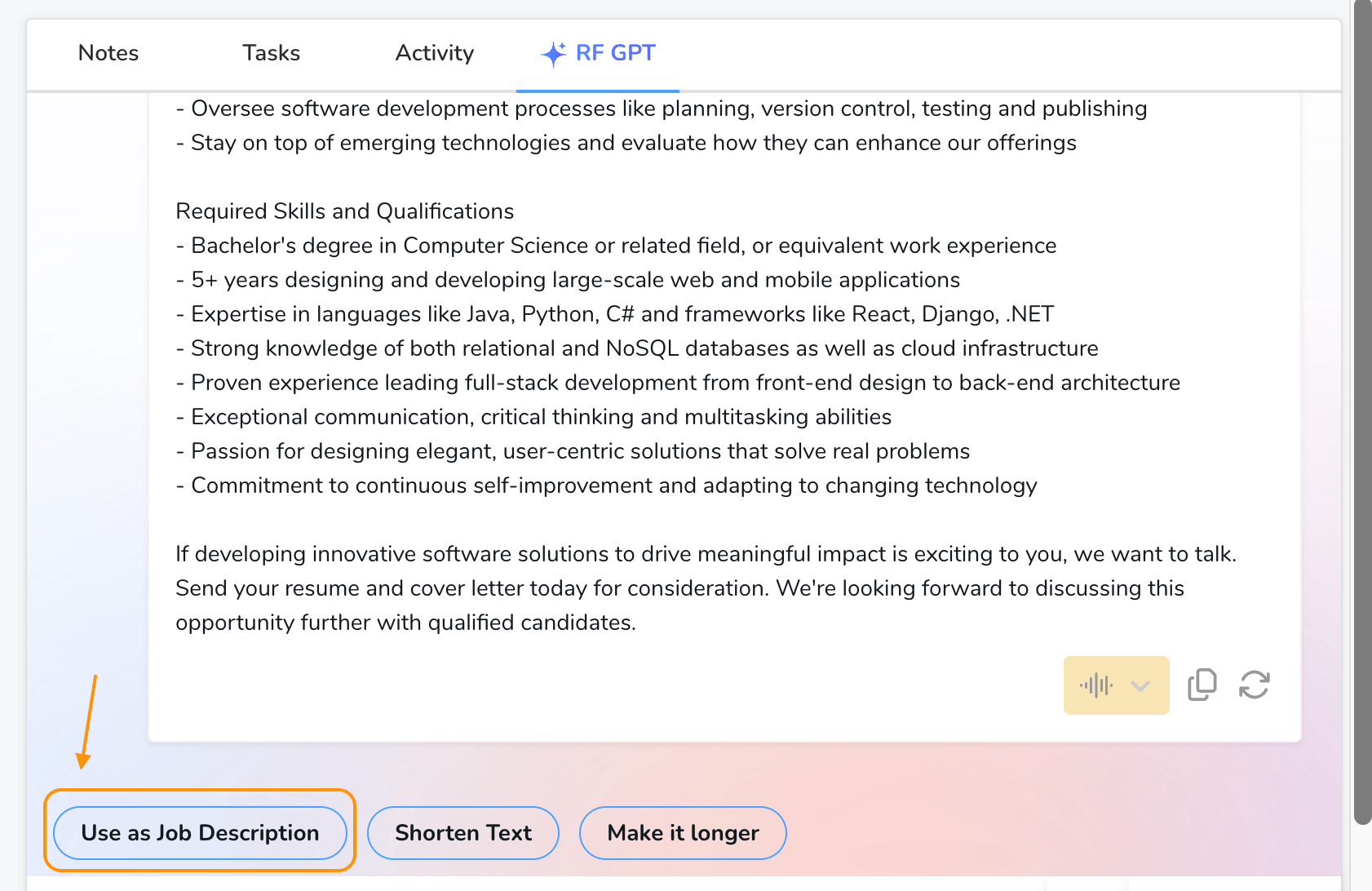
NOTE: RF GPT is now AIRA (AI Recruiting Assistant)
Set Up Your Recruitment Timeline
Ever found yourself scrambling to fill a position because someone quit unexpectedly? A recruitment timeline helps prevent that crisis mode.
- Establish realistic timelines for each recruitment phase
- Set clear expectations with hiring managers about timeframes
- Create a communication plan for regular updates to stakeholders
Pro tip: Use tools like Recruiterflow to visualize & automate your recruitment pipeline and keep everyone on track. You can organize your recruiting stages visually and easily track candidates through different stages of the recruitment process.

Stage 2: Sourcing & Attraction
Now that you know who you’re looking for, it’s time to go find them! This stage is all about building a qualified candidate pool through various channels.
Actions Recruiters Can Take:
Build Your Employer Brand
Before candidates consider your job, they’ll consider your company. A strong employer brand is your secret weapon in attracting top talent.
- Showcase your company culture through social media
- Share employee success stories and spotlight videos
- Highlight development opportunities and career paths
Multi-Channel Sourcing Strategy
Gone are the days when posting on a job board was enough. Today’s successful recruiters fish in multiple ponds.
- Leverage job platforms and niche job boards
- Implement social media recruiting campaigns
- Develop employee referral programs (the highest quality source!)
- Use AI-powered recruiting tools to identify passive candidates
Personalized Outreach
Mass messaging doesn’t cut it anymore. Personalization is key to getting responses from qualified candidates.
- Research candidates before reaching out
- Reference specific achievements or experiences
- Explain why they specifically would be a good fit
- Avoid generic templates that scream “mass email”
Tool Recommendation: Try Recruiterflow for personalized outreach templates that can be customized at scale while maintaining that personal touch.
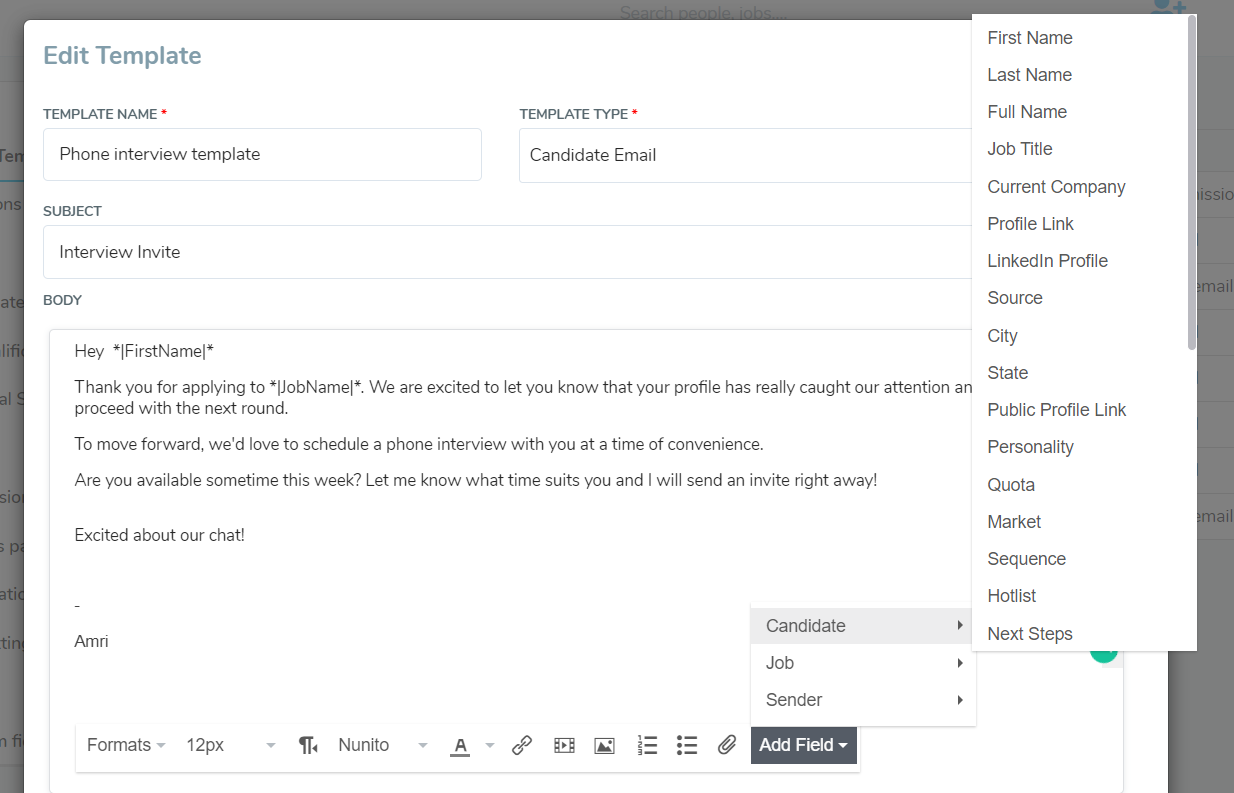
Stage 3: Screening & Assessment
Drowning in applications? This stage helps you efficiently identify the diamonds in the rough.
Actions Recruiters Can Take:
Initial Application Review
First impressions matter, and this is where you make yours about each candidate.
- Develop a systematic approach to reviewing resumes and cover letters
- Look for alignment with the must-have qualifications
- Note red flags and potential areas for deeper investigation
- Track promising candidates for future roles even if they’re not right for this one
Pre-Interview Assessments
Want to save time in interviews? Pre-assessments can help weed out candidates who look good on paper but lack the necessary skills.
- Implement skills tests relevant to the position
- Use situational judgment assessments for role-specific scenarios
- Consider personality assessments for cultural fit evaluation
Preliminary Phone Screening
A quick call can save hours of in-person interview time later.
- Prepare a structured set of questions that verify the must-have qualifications
- Assess communication skills and professional demeanor
- Clarify salary expectations and availability
- Evaluate genuine interest in the role and company
Pro Tip: Try AI-driven candidate matching with Recruiterflow. It uses AI to recommend the perfect candidates based on role requirements.
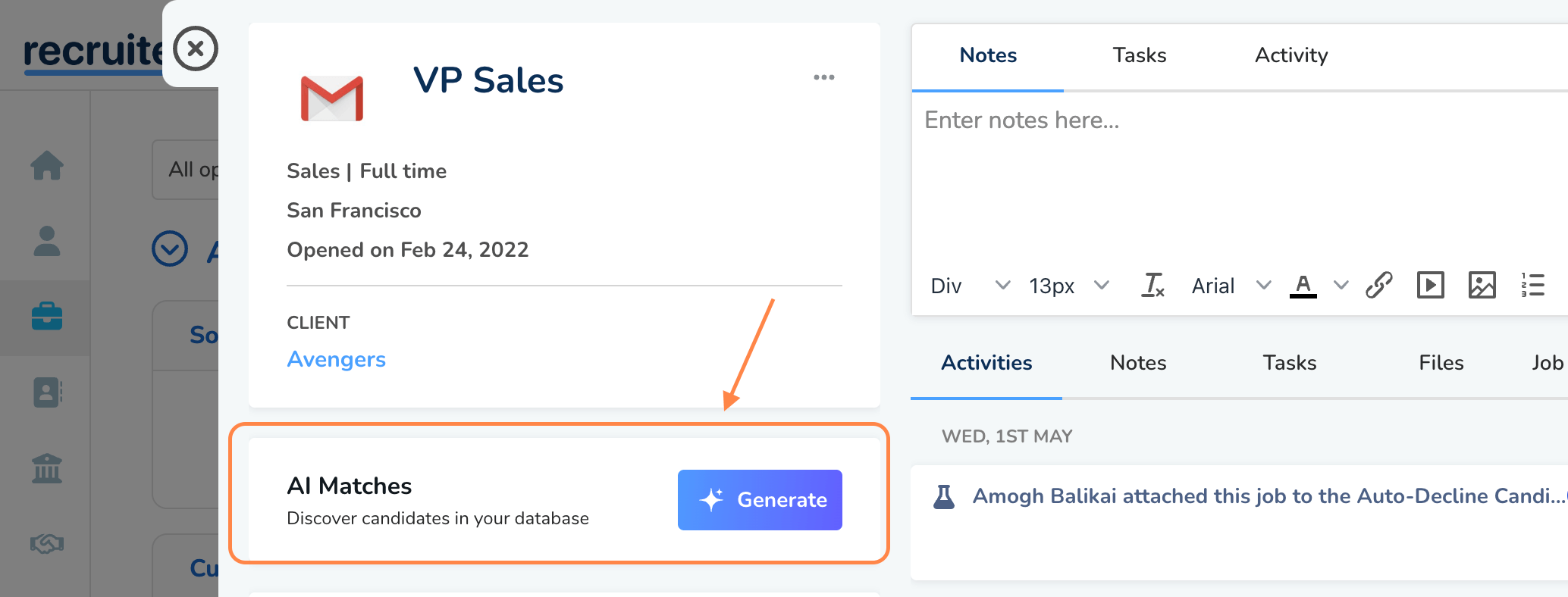
Stage 4: Interviewing & Selection
This is where the recruitment magic happens – you turn prospective candidates into future employees.
Actions Recruiters Can Take:
Structured Interview Process
Random questioning leads to random results. Structure is your friend here.
- Develop standardized questions for each role
- Include behavioral, situational, and competency-based questions
- Train interviewers on bias recognition and mitigation
- Create evaluation rubrics for objective candidate comparison
Also, check out our blog on recruiter training to learn how to turn good recruiters into great ones.
Collaborative Assessment
Two heads (or more) are better than one when making hiring decisions.
- Involve team members who will work directly with the new hire
- Gather diverse perspectives on each candidate
- Use data-driven decision-making alongside gut feelings
Competency Validation
Trust, but verify. This is where you confirm that candidates can actually do what they claim.
- Assign relevant work samples or case studies
- Conduct technical assessments for specialized roles
- Set up role-playing scenarios for client-facing positions
Pro tip: Use interview scorecards to rate candidates based on different criteria. Recruiterflow interview scorecards help you with this. On top of scoring, your entire team can include their feedback as well.
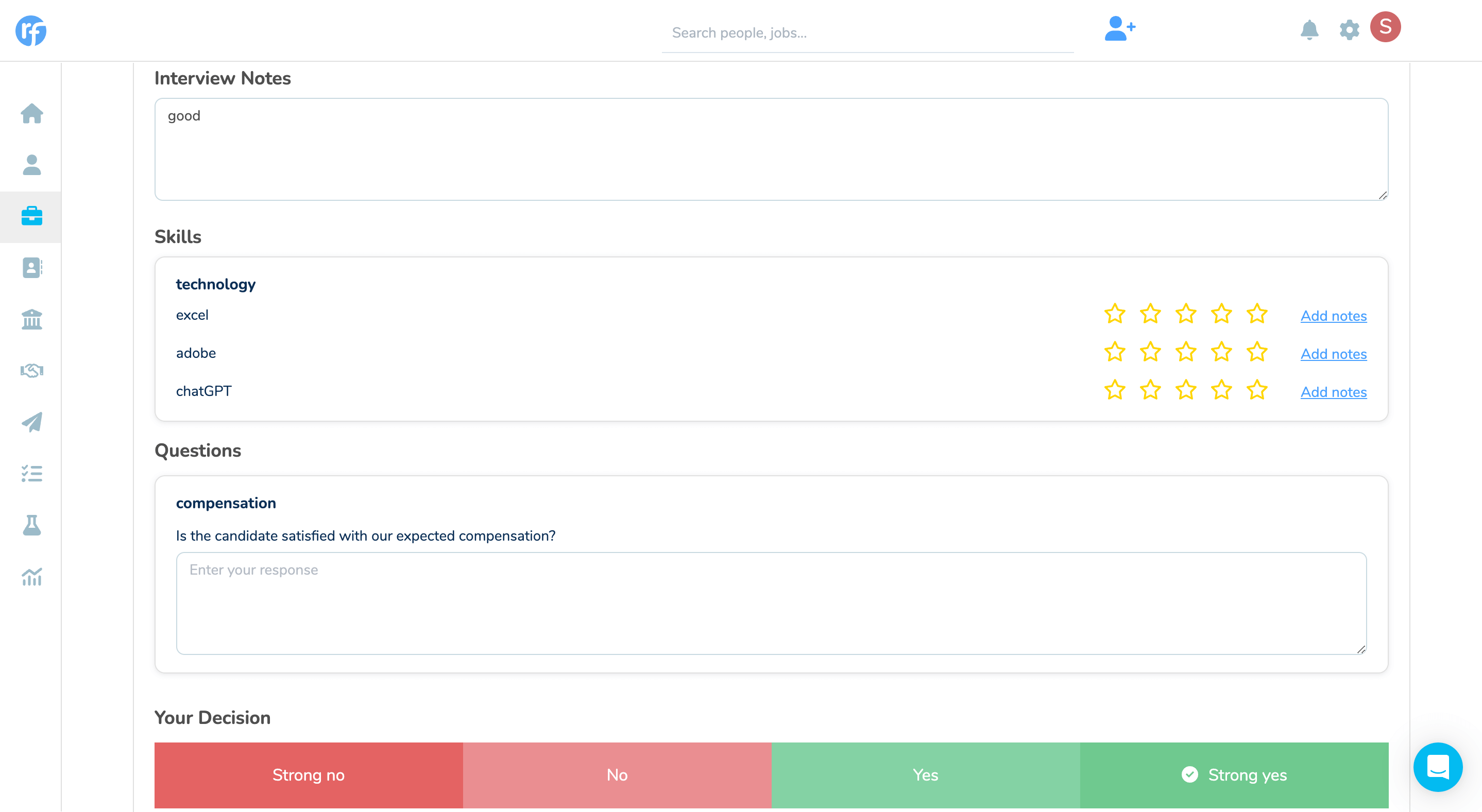
Stage 5: Hiring & Offer Management
You’ve found your ideal candidate – now don’t lose them with a clumsy offer process!
Actions Recruiters Can Take:
Craft the Perfect Offer
An offer is more than just a salary figure – it’s a complete package that needs to excite your candidate.
- Research market rates to ensure competitive compensation
- Highlight unique benefits and perks beyond the salary
- Personalize aspects of the offer when possible
- Create urgency without applying undue pressure
Negotiation Management
Be prepared for some back-and-forth – it’s a normal part of the process.
- Establish your flexibility boundaries beforehand
- Listen actively to candidate concerns and priorities
- Maintain relationship quality even during tough negotiations
Background & Reference Checks
The final verification before sealing the deal.
- Verify employment history and educational credentials
- Conduct thorough reference checks with specific questions
- Ensured legal compliance throughout the verification process
Pro Tip: Always get the candidate’s permission before contacting references, and be clear about what information you’re seeking.
Stage 6: Onboarding & Integration
The recruitment cycle doesn’t end with a signed offer letter – proper onboarding is crucial for long-term success.
Actions Recruiters Can Take:
Pre-Day One Preparation
The time between offer acceptance and the start date is golden for setting the tone.
- Send welcome packages and company swag
- Provide access to necessary systems and documentation
- Connect new hires with team members before they start
- Create a detailed first-week schedule
Structured Onboarding Program
First impressions last, and a poor onboarding experience can lead to early turnover.
- Design role-specific training schedules
- Arrange introductions to key stakeholders
- Set clear expectations and initial objectives
- Schedule regular check-ins during the first 90 days
Cultural Integration
Technical skills get people hired, but cultural fit keeps them around.
- Organized team-building activities and social events
- Assign mentors or buddies to new hires
- Create opportunities for early wins and contributions
Stage 7: Feedback & Optimization
The final stage is often overlooked but is critical for continuously improving your recruitment process.
Actions Recruiters Can Take:
Conduct Candidate Experience Surveys
How did candidates perceive your process? Both hires and non-hires can provide valuable insights.
- Send surveys at various stages of the recruitment process
- Ask specific questions about each recruitment phase
- Gather suggestions for improvements
Hiring Manager Satisfaction
Are your internal customers happy with the candidates you’re providing?
- Check in on new hire performance at 30, 60, and 90 days
- Identify common pain points and areas for improvement
- Celebrate successful placements and learn from less successful ones
Optimize Your Processes
Use data to continually refine your approach.
- Track key metrics like time-to-fill, cost-per-hire, and quality-of-hire
- Analyze bottlenecks in your recruitment funnel
- A/B test different sourcing channels and messaging approaches
- Regularly update your processes based on changing market conditions
Pro Tip: Use Recruiterflow to track all the crucial recruiting metrics. Its real-time dashboards aggregate data across the entire recruiting funnel and provide actionable insights to refine your 360-degree recruiting approach.
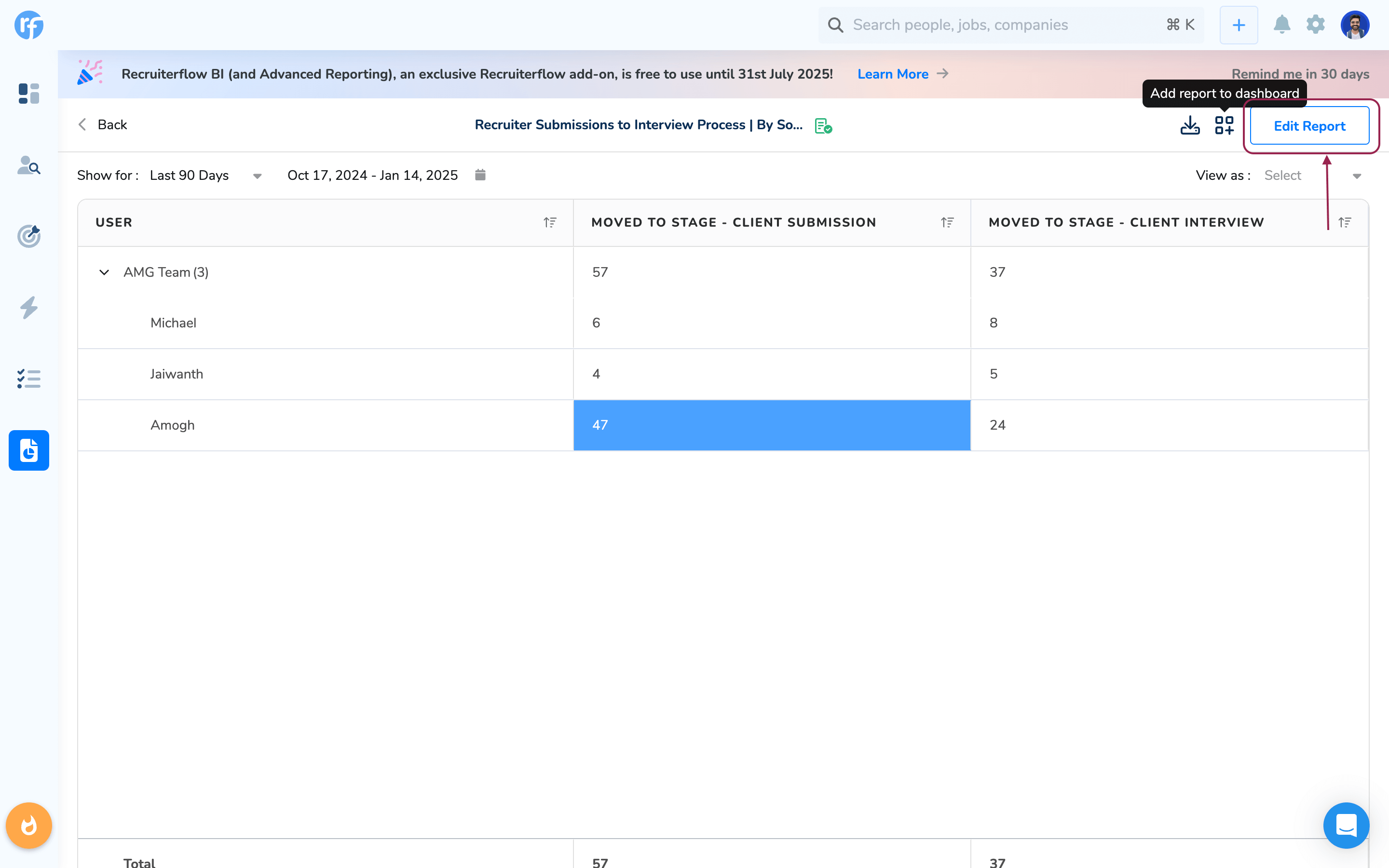
Best Practices for Implementing 360 Recruitment
The right implementation strategies can make or break your 360 recruitment efforts. Let me walk you through the proven best practices that will help you nail this approach.
1. Define Clear Processes for Each Recruitment Stage
It’s hard to implement 360 recruitment without clearly defined processes. You need a roadmap for every single stage.
Start by mapping out each step of your recruitment cycle:
- Preparation phase: Document how you’ll define candidate personas and create job descriptions.
- Sourcing strategy: Outline your methods for finding candidates (social, referrals, direct sourcing).
- Screening protocols: Establish consistent evaluation criteria.
- Selection framework: Define your interview stages and decision-making process.
- Hiring procedures: Create templates for offers and negotiations.
- Onboarding checklist: Design a comprehensive first 90-day plan.
Pro Tip: Use process mapping tools like Lucidchart or Miro to visualize your entire recruitment workflow. Share this with your team so everyone understands how each piece fits together.
2. Leverage Technology and AI Strategically
In 2025, these are some of the must-have tools:
- Applicant Tracking System (ATS): The backbone of your 360 recruitment process
- AI-powered sourcing tools: For identifying passive candidates
- Video interview Software: To assess candidates remotely
- Candidate Assessment technology: For skills and cultural fit evaluation
- Recruiting CRM software: To maintain relationships with candidates in your pipeline
3. Build and Showcase a Compelling Employer Brand
Your employer brand isn’t just nice to have – it’s critical ammunition in the war for talent.
Here are some employer branding tactics that work:
- Create authentic employee spotlight videos showing a day in the life at your client companies
- Develop content that highlights company culture, values, and growth opportunities
- Leverage social proof through testimonials and success stories
- Maintain an active and engaging social media presence
Have you considered how your agency’s brand and your clients’ brands work together? A strong alignment here creates a powerful recruitment message.
4. Prioritize Candidate Experience at Every Touchpoint
86% of candidates prioritize a smooth experience when evaluating job offers.
Here’s how to improve your candidate experience:
- Personalized communication: Address candidates by name and reference specific details from their application
- Transparent processes: Clearly communicate timelines and expectations at each stage
- Regular updates: Never leave candidates in the dark – provide status updates even when there’s no news
- Feedback loops: Collect and act on candidate feedback to continuously improve your process
- Post-interview follow-ups: Send personalized thank-you notes within 24 hours
5. Implement Structured, Bias-Free Interview Processes
Are your interviews consistent and fair across all candidates? If not, you’re missing a major opportunity to improve your hiring quality.
Create better interview frameworks:
- Develop standardized questions based on job requirements and soft skills
- Train all interviewers on unconscious bias and fair evaluation techniques
- Use scoring rubrics to objectively compare candidates
- Incorporate diverse interview panels to gain multiple perspectives
Consider implementing behavioral-based interview questions to assess how candidates have handled situations in the past – they’re significantly more predictive of future performance than hypothetical questions.
6. Streamline Your Onboarding Process
Recruitment doesn’t end with the offer acceptance. The onboarding phase is critical for retention and productivity.
Onboarding excellence checklist:
- Pre-start communication plan
- Day one agenda template
- First-week schedule
- 30-60-90 day goals framework
- Buddy/mentor pairing system
- Regular check-in schedule
Tool Recommendation: Platforms like BambooHR or Enboarder can automate much of the onboarding process while maintaining a personal touch.
7. Develop Robust Metrics and Analytics Capabilities
How do you know if your 360 recruitment strategy is actually working? You need metrics – and not just time-to-hire.
Key metrics to track:
- Source effectiveness (which channels produce the best candidates)
- Quality of hire (performance ratings, retention, hiring manager satisfaction)
- Candidate experience scores
- Cost per hire across different roles
- Time-to-productivity for new hires
- Recruiter efficiency metrics
8. Invest in Continuous Training for Your Recruitment Team
A 360 recruitment approach demands a broader skill set from your recruiters. They’re no longer just sourcers or interviewers – they’re end-to-end talent acquisition specialists.
Essential skills for 360 recruiters:
- Talent marketing and employer branding
- Advanced sourcing techniques
- Interview and assessment expertise
- Negotiation skills
- Relationship management
- Data analysis and reporting
- Industry and market knowledge
Common Challenges in 360 Recruitment
The 360 model, where you handle everything from business development to candidate sourcing and placement, comes with some serious hurdles that can make even the most seasoned recruiters question their career choices.
1. The Burnout Epidemic
Ever felt like you’re running on fumes by Wednesday afternoon? That’s the notorious 360 burnout creeping in.
The multitasking demands of the 360 model frequently lead to chronic exhaustion, with recruiters struggling to balance client acquisition, relationship management, and candidate sourcing simultaneously.
Studies suggest that specializing roles (as in 120 or 180 models) can triple productivity compared to the traditional 360 approach.
According to industry analysis, the 360 model stretches recruiters “too thin, often leading to burnout akin to a ham sandwich without the ham—basically pointless”.
2. The Skills Mismatch Dilemma
Here’s the thing about being a 360 recruiter – you’re expected to be equally brilliant at sales, marketing, candidate screening, negotiations, and admin.
But let’s get real – who’s actually wired that way?
- The jack-of-all-trades problem: The model expects recruiters to master vastly different skill sets, which often leads to underperformance in areas that don’t align with their natural strengths.
- Knowledge gaps: When a high-performing 360 recruiter leaves, they take specialized client knowledge and candidate relationships with them. This can create significant organizational vulnerabilities.
- Competitive disadvantage: Specialized recruiters in 120 or 180 models can develop deeper expertise and networks in specific areas, giving them an edge over generalists.
3. Resource Intensity That Breaks Budgets
The 360 model is incredibly resource-intensive, which creates particular challenges for smaller agencies and teams.
- Time constraints: Managing full recruitment cycles for multiple roles simultaneously creates severe time management challenges.
- Training investment: Developing proficiency across all recruitment functions requires extensive training and continuous development.
- Financial impact: The Society for Human Resource Management (SHRM) found that companies can lose up to $240,000 for each hire that is poorly aligned with their organizational culture – a risk that increases when recruiters are stretched thin.
4. The Technology-Human Balance
In today’s recruitment world, technology is both your best friend and your worst enemy.
- Automation pitfalls: While tech tools streamline processes, over-reliance can make candidate experiences feel “as personal as a text from a chatbot”.
- Integration challenges: Most agencies struggle to find and implement technology solutions that effectively support all aspects of the 360 process.
- Data overload: LinkedIn research reveals that 70% of recruiters acknowledge that data-driven hiring can lead to oversights in understanding candidate potential beyond hard metrics.
5. Unrealistic Expectations from All Sides
The expectations placed on 360 recruiters can sometimes border on superhuman.
- Client demands: Organizations often have unrealistic expectations about timelines and candidate quality.
- Candidate experience: With limited time per candidate, providing exceptional experiences becomes increasingly challenging.
- Internal metrics: Agencies frequently set competing KPIs that pull recruiters in different directions (sales vs. quality placements).
Metrics to Measure the Success of 360 Recruitment Strategy
Metrics will be your best friend in proving your value and constantly improving your 360 recruitment process. In the competitive world of recruitment, gut feelings just don’t cut it anymore. Having concrete data allows you to:
- Make informed business decisions rather than shooting in the dark
- Identify bottlenecks in your recruitment funnel
- Justify your value to clients with hard evidence
- Continuously refine your approach for better results
Here are the core performance metrics every 360 recruiter should track:
Time-to-Hire
This classic metric measures how long it takes to fill a position from job posting to acceptance. For 360 recruiters, breaking this down into stages can reveal where your process excels or lags.
Top job candidates are typically hired within 10 days. If your time-to-hire exceeds this benchmark, it might be time to streamline your process.
How to improve it:
- Audit your current workflow to identify time-consuming stages
- Implement automated screening tools
- Establish clear timelines for each recruitment phase
Cost-per-Hire
This isn’t just about how much you spend advertising a position. For 360 recruitment, calculate:
- Advertising costs
- Recruiter time (valued at hourly rates)
- Technology investments
- Administrative costs
- Onboarding expenses
Pro tip: Compare your cost-per-hire against industry benchmarks. If you’re consistently spending more, it might indicate inefficiencies in your process that need addressing.
Quality-of-Hire
This is where things get juicy! Quality of hire is an aggregate metric that evaluates the long-term value new employees bring to an organization. It’s perhaps the most important metric, as it directly reflects on your ability to find candidates who truly fit.
To measure it effectively:
- Define clear performance benchmarks specific to each role
- Track retention rates of placed candidates
- Measure time-to-productivity for new hires
- Gather 360-degree feedback from various stakeholders
- Use advanced analytics to identify patterns in successful placements
Remember, a truly successful 360 recruiter doesn’t just fill positions—they place candidates who thrive long-term.
Now, let’s look at the candidate-focused metrics that help you understand your candidate experience. After all, in today’s talent-driven market, how candidates feel about your process matters enormously.
Candidate Satisfaction
Candidate satisfaction measures what candidates really think about your recruitment process—and it can significantly impact your agency’s reputation.
According to industry data, 86% of employees look at company reviews and ratings before applying for a job, and 50% won’t apply to a company with a bad reputation. Yikes!
How to measure it:
- Send short surveys after key touchpoints
- Track your ratings on recruitment platforms
- Monitor social media mentions
- Calculate your candidate’s Net Promoter Score (NPS)
Interview-to-Hire Ratio
This metric shows how many candidates you need to interview before making a successful hire. The ideal ratio is 3:1 or better.
A high ratio may indicate:
- Poor candidate screening earlier in the process
- Misalignment between job descriptions and actual requirements
- Ineffective interviewing techniques
By improving this ratio, you’ll save time for both your team and your candidates while enhancing the overall candidate experience.
Application Completion Rate
How many candidates start but don’t finish your application process? A low completion rate often signals that your application is too lengthy or complicated.
In fact, making a job application mobile-friendly alone increases applicants by more than 11%. That’s a significant boost for such a simple fix!
Client-focused metrics help you demonstrate your value to your clients:
Hiring Manager Satisfaction
Regularly survey your clients to gauge their satisfaction with:
- Quality of candidates presented
- Speed of the recruitment process
- Communication throughout
- Overall service
This feedback is gold for improving your client relationships and retention.
Offer Acceptance Rate
What percentage of candidates accept your client’s job offers? A low acceptance rate might indicate:
- Misalignment in salary expectations
- Poor candidate experience
- Insufficient selling of the opportunity
In a recent case study, a company partnering with a recruitment process outsourcing (RPO) provider saw significant improvements in both interview show rates and offer rates.
Client Retention Rate
The ultimate measure of client satisfaction is whether they come back for more. Track what percentage of clients return with new positions within 6-12 months.
Long-term success metrics help you assess the sustainable impact of your 360 recruitment efforts:
Retention Rate of Placed Candidates
Are your placements sticking? Track what percentage of candidates remain with the company after 90 days, 6 months, and 1 year. A high retention rate demonstrates your ability to make quality matches that benefit both candidates and clients long-term.
Revenue per Recruiter
At the end of the day, your agency needs to make money. Calculate:
- Total revenue generated divided by the number of recruiters
- Average fee per placement
- Revenue growth year-over-year
This metric helps you assess the efficiency and productivity of your team while identifying top performers whose strategies others might adopt.
Tools to Track Your Metrics
- Applicant Tracking Systems (ATS): Platforms like Recruiterflow offer built-in analytics specifically designed for recruitment agencies
- Business Intelligence (BI) Tools: Recruiterflow, Power BI, or Tableau can help you visualize recruitment data.
- Candidate Experience Platforms: Tools like Starred or SurveyMonkey for gathering candidate feedback
- CRM Systems: For tracking client relationships and satisfaction
Pro tip: Invest in an ATS with advanced analytics capabilities to gain actionable insights that can refine your entire 360 recruitment process.
Ready to implement a metrics-driven approach? Here’s your action plan:
- Select your key metrics: Don’t try to track everything at once. Choose 5-7 metrics that align with your agency’s goals.
- Establish baselines: Measure where you stand now to have a benchmark for improvement.
- Set realistic targets: Based on industry standards and your baseline, establish achievable goals.
- Create a dashboard: Develop a visual representation of your metrics that’s accessible to your team.
- Schedule regular reviews: Meet monthly to discuss trends and quarterly to make strategic adjustments.
- Share success stories: When metrics improve, celebrate and analyze what worked so it can be replicated.
Does this sound like a lot of work? Initially, yes. But once you have the systems in place, the insights you gain will be worth their weight in gold.
Plus, having concrete data to show clients puts you miles ahead of competitors who rely on vague promises and gut feelings.
Frequently Asked Questions
What is 360 recruitment?
360 recruitment, also known as full-cycle or end-to-end recruitment, is a comprehensive hiring approach where a single recruiter manages the entire recruitment process from start to finish.
This includes:
- Creating job descriptions
- Sourcing candidates
- Screening applications
- Conducting interviews
- Making job offers
- Onboarding new hires
The goal is to ensure a seamless and efficient hiring experience for both the organization and the candidates.
How does 360 recruitment differ from traditional recruitment?
In traditional recruitment, different recruiters may handle various stages of the hiring process, such as sourcing, screening, and onboarding. This can lead to delays and miscommunications.
In contrast, 360 recruitment involves one recruiter overseeing all aspects, which enhances accountability and consistency throughout the recruitment cycle.
How does 360 recruitment differ from 180 recruitment?
The primary difference between 360 and 180 recruitment lies in the scope of responsibilities.
A 360 recruiter manages the entire recruitment lifecycle, from identifying job openings and sourcing candidates to client management and onboarding. This model requires a broader skill set, as it combines both sales and relationship-building aspects.
In contrast, 180 recruitment focuses on either candidate sourcing or client acquisition, which allows recruiters to specialize in one area. This can lead to a disconnect between the client’s needs and the candidate’s qualifications, as it does not cover the entire recruitment process.
What are the benefits of 360 recruitment?
The key benefits of 360 recruitment include:
- Consistency and Accountability: One recruiter manages the entire process, which ensures a uniform approach.
- Enhanced Candidate Experience: Candidates interact with a single point of contact, which often leads to a more personalized experience.
- Improved Hiring Efficiency: Streamlines the process under one recruiter and minimizes delays and miscommunications.
- Stronger Client/Stakeholder Relationships: Continuous interaction helps understand needs better and fosters productive relationships.
- Comprehensive Market Insights: Recruiters stay informed about industry trends so they can continue to provide valuable insights to clients and candidates.
What are the challenges of 360 recruitment?
While 360 recruitment has many advantages, it also presents challenges, such as:
- Resource Intensity: It requires significant time and effort from the recruiter.
- Complexity: The comprehensive nature can be overwhelming, especially for smaller organizations.
- Dependence on Skilled Recruiters: The success of the process heavily relies on the competence of the recruiter managing it.
What are the stages involved in the 360 recruitment process?
The 360 recruitment process typically includes the following stages:
- Preparation: Identifying talent gaps and understanding role requirements.
- Sourcing: Actively searching for candidates through various channels.
- Screening: Reviewing applications and conducting initial assessments.
- Selection: Making decisions based on interviews and assessments.
- Hiring: Extending job offers to selected candidates.
- Onboarding: Integrating new hires into the organization.
What are the main tools for 360 recruitment?
Key tools for 360 recruitment include:
- Applicant Tracking Systems (ATS): These systems help manage job postings and candidate applications, and streamline the hiring process.
- Customer Relationship Management (CRM) Systems: Useful for managing relationships with clients and candidates; helps ensure effective communication throughout the recruitment cycle.
- Assessment Tools: Tools for evaluating candidates’ skills and fit for the role, which can include online testing and structured interview frameworks.
Is 360 recruitment suitable for all organizations?
360 recruitment may not be suitable for every organization, particularly larger ones with high-volume hiring needs. The approach can be time-consuming and less scalable compared to models where responsibilities are divided among multiple recruiters.
Learn How Recruiterflow Can Help You with Full-Cycle Recruiting
An end-to-end recruitment software like Recruiterflow helps you automate every step of the 360-degree recruitment process. It unifies all stages to ensure a cohesive, data-driven process that aligns with modern full-cycle recruiting best practices.

It’s an AI-first command center that ambitious agencies use to manage their recruitment operations. Your agency gets everything it needs to optimize its recruitment operations:
- Unified ATS & CRM
- Centralized candidate database
- No-code recruiting automation
- Automated, multi-channel outreach (Email, SMS, Call, & Socials)
- AI-first screening and sourcing tools
- Data enrichment capabilities
- Advanced reporting and analytics
- Open APIs and a host of integrations
Scott S., a Recruitment Specialist, reviewed us on G2Crowd:
“I’ve been using Recruiterflow, and it’s been a game-changer for streamlining my recruitment process. The automation tools for campaigns to candidates, LinkedIn, email integration, and customizable pipelines make managing candidates and clients so much easier. I love how it cuts down on manual work, letting me focus on building relationships instead of chasing admin tasks.”
See it in action now: Book a free demo
Recruitment





Pragadeesh Natarajan